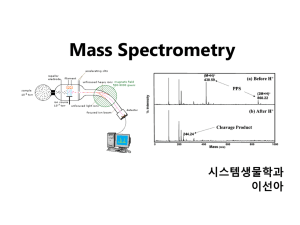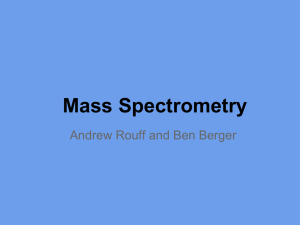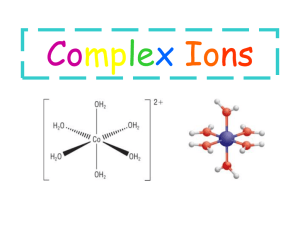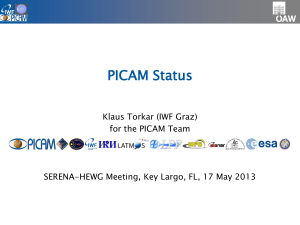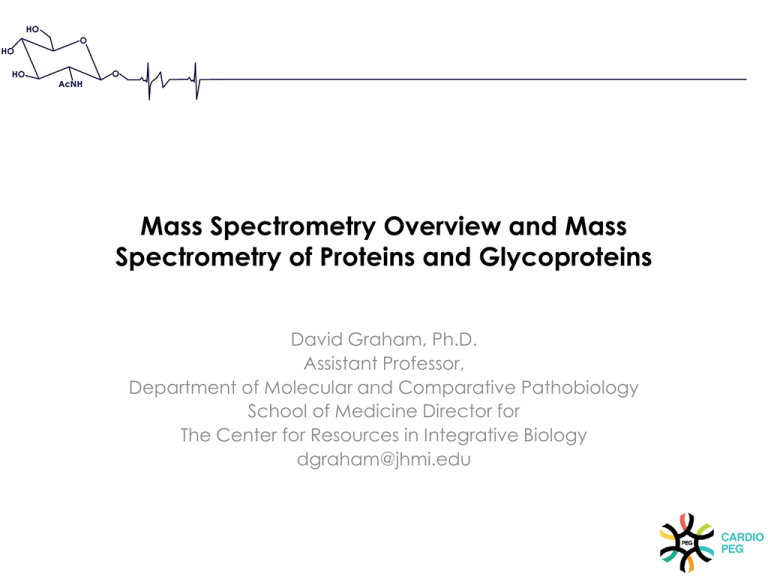
HO
O
HO
HO
AcNH
O
Mass Spectrometry Overview and Mass
Spectrometry of Proteins and Glycoproteins
David Graham, Ph.D.
Assistant Professor,
Department of Molecular and Comparative Pathobiology
School of Medicine Director for
The Center for Resources in Integrative Biology
dgraham@jhmi.edu
HO
Goals
O
HO
HO
AcNH
O
• Better Understanding of Mass Spectrometry
–
–
–
–
–
–
Basic introduction
Components of MS
Basic Principles
Types of instruments
MS as applied to proteins, peptides and glycopeptides
ECD/ETD
• Analyzing MS data
– Software tools
– Workflows
– Extracting Biological Meaning
HO
Sources:
O
HO
HO
AcNH
O
• Agard lab
– www.msg.ucsf.edu/agard/maldi/IntrotoMS.ppt
• Cobb lab
– shadow.eas.gatech.edu/~kcobb/isochem/lectures/lecture2_masssp
ec.ppt
• ME 330.804: Mass Spectrometry in an “Omics” World
– Johns Hopkins – multiple faculty contributers
MAMSLAB: Slides from the late Robert Cotter
Books:
Mass Spectrometry of Glycoproteins : Methods and Protocols
Editor(s): Jennifer J. Kohler1, Steven M. Patrie2
Mass Spectrometry of Proteins and Peptides : Mass Spectrometry
of Proteins and Peptides
• Editor(s): John R. Chapman1
•
•
•
•
•
– Both available through welch medical library online
HO
More..
O
HO
HO
AcNH
O
• The Expanding Role of Mass Spectrometry in Biotechnology,Gary
Siuzdak (2nd edition 2006) ISBN 0-9742451-0-0
• Mass Spectrometry Desk Reference, O. David Sparkman (2000, 1st
edition) ISBN 0-9660813-2-3
• Mass Spectrometry of Biological Materials, Barbara S. Larsen &
Charles N. McEwen (2nd. Edition 1998) ISBN 978-0824701574
• Proteins and Proteomics: A Laboratory Manual, edited by Richard
Simpson (2003) ISBN 0-87969-554-4
• Mass Spectrometry in Biophysics: Conformation and Dynamics of
Biomolecules, Igor A. Kaltashov and Stephen J. Eyles (2005) ISBN
0-471-45602-0
• Time-of-Flight Mass Spectrometry: Instrumentation and
Applications in Biological Research, Robert J. Cotter (1997) ISBN 08412-3474-4
• Disclaimer – best effort has been made to reference original
sources. Please contact dgraham@jhmi.edu for correction of any
errors or ommisions.
HO
Mass spectrometry is applied physics
O
HO
HO
O
AcNH
•
•
•
•
Magnetism
Newtons laws of motion
Basic tennants are dealing with charged molecules
Two laws:
– Lorenz force law:
– If a particle of charge q moves with velocity v in the presence of an
electric field E and a magnetic field B, then it will experience a force
(F)
•
– Newtons second law (non-relatavistic motion):
•
F=ma
– The terms F can be related and the equation derived:
• (m/q)a= E + v x B
HO
Basic equations governing mass spectrometry
O
HO
HO
AcNH
O
1 2
mv zV
2
Ion’s kinetic E function of accelerating voltage (V) and charge (z).
F mv 2 / R
F Bzv
mv 2 / R Bzv
Centrifugal force
Applied magnetic field
balance as ion goes through flight tube
Combine equations to obtain:
m / z B 2 R 2 / 2V
Fundamental equation of mass spectrometry
Change ‘mass-to-charge’ (m/z) ratio by
changing V or changing B.
NOTE: if B, V, z constant, then:
r m
Cobb lab
HO
What is the take home point?
O
HO
HO
AcNH
•
•
•
•
O
We can control our voltages
We know our distances
We know our field strengths
Thus:
– A simple set of equations can be used to calculate the m/z for all
different types of mass spectrometers
HO
Basic components of a mass spectrometer
O
HO
HO
AcNH
O
Sample
Ion source:
makes ions
Modified from Agard lab
Mass
analyzer:
separates
ions
Detector:
presents
information
HO
O
HO
HO
AcNH
O
Mass Spectrometer Block Diagram
High Vacuum System
Inlet
Ion
source
Modified from Agard lab
Mass
Analyzer
Detector
Data
System
HO
O
HO
HO
AcNH
O
Mass Spectrometer Block Diagram
High Vacuum System
Inlet
Ion
source
Modified from Agard lab
Mass
Analyzer
Turbo pumps
Detector
Data
System
HO
O
HO
HO
AcNH
Sample Introduction
O
High Vacuum System
Inlet
Ion
Source
HPLC
Flow injection
Sample plate
Modified from Agard lab
Mass
Analyzer
Detector
Data
System
HO
O
HO
HO
AcNH
Ion Source
O
High Vacuum System
Inlet
Ion
Source
MALDI
ESI
FAB
SIMS
EI
CI
Modified from Agard lab
Mass
Analyzer
Detector
Data
System
HO
O
HO
HO
AcNH
O
Ion Sources make ions from sample molecules
(Ionization is required to move and detect molecules.)
Electrospray ionization:
Pressure = 1 atm
Inner tube diam. = 100 um
Partial
vacuum
Sample Inlet Nozzle
(Lower Voltage)
MH+
N2
Sample in solution
N2 gas
+
+ ++
++
++++
++
+
+ ++
++
+
++
+
++
+
+
++
+
++
+
++
+
++
+ +
+
+
+
+
+
+
MH2+
+
MH3+
High voltage applied
to metal sheath (~4 kV)
Charged droplets
Introduced by John Fenn (Nobel Prize 2002):
Yamashita, M.; Fenn, J.B., J. Phys. Chem. 88 (1984) 4451.
Whitehouse, C.M.; Dreyer, R.N.; Yamashita, M.; Fenn, J.B., Anal. Chem. 57 (1985) 675.
Fenn, J.B.; Mann, M.; Meng, C.K.; Wong, S.F.; Whitehouse, C.M., Science 246 (1989) 64.
Sources: Agard lab and MAMSLAB
HO
O
HO
HO
AcNH
O
Favors ejection of multiply charged
Ions
Based on an ion evaporation model:
Iribarne, J.V.; Thomson, B.A., J. Chem. Phys. 64 (1976) 2287.
Thomson, B.A.; Iribarne, J.V., J. Chem. Phys. 71 (1979) 4451.
Sources: Agard lab and MAMSLAB
HO
Assisted Electrospray
O
HO
HO
O
AcNH
Low Voltage (0.1 kv)
Low Voltage (0.5 kv)
High Voltage (5 kv)
MS
LC Column Flow
Drying
Gas
Nebulizing
Gas
www.e-cats.com/chemistry/01measurements/IntrotoMassSpec.ppt
HO
O
MALDI: Matrix Assisted Laser Desorption Ionization
HO
HO
AcNH
O
Sample plate
Laser
hn
MH+
+/- 20 kV
Grid (0 V)
1. Sample is mixed with matrix
(X) and dried on plate.
2. Matrix absorbs UV or IR
energy from laser
3. Matrix ionizes and
dissociates; undergoes a
phase change to
supercompressed gas
4. Some analytes are ionized by
proton transfer: XH+ + M
MH+ + X.
5. Matrix expands
supersonically and ions are
entrained in the plume
Koichi Tanaka (Nobel Prize 2002)
Modified from Agard lab and Cotter lab (MAMSLAB)
HO
Common MALDI Matrices
O
HO
HO
AcNH
O
Source: MAMSLAB
HO
O
HO
HO
AcNH
Mass Analyzer
O
High Vacuum System
Inlet
Ion
source
Mass
Analyzer
Time of flight (TOF)
Quadrupole
Ion Trap
Orbitrap
Magnetic Sector
FTMS
Modified from Agard lab
Detector
Data
System
HO
O
HO
HO
AcNH
O
Mass analyzers
¤ Mass analyzers separate ions based on their mass-tocharge ratio (m/z)
¤ Operate under high vacuum (keeps ions from bumping
into gas molecules)
¤ Actually measure mass-to-charge ratio of ions (m/z)
¤ Key specifications are resolution, mass measurement
accuracy, and sensitivity.
¤ Several kinds exist: for bioanalysis, quadrupole, time-offlight and ion traps are most used.
Modified from Agard lab
HO
O
HO
HO
AcNH
O
Quadrupole Mass Analyzer
Uses a combination of RF and
DC voltages to operate as a
mass filter.
• Has four parallel metal
rods.
• Lets one mass pass
through at a time.
• Can scan through all
masses or sit at one
fixed mass.
Modified from Agard lab
HO
O
HO
HO
AcNH
Quadrupoles have variable ion transmission modes
O
m2
m4
m1
m4
m3
m2
m2
m2
m1
m3
mass scanning mode
m2
m4
m1
m3
m2
single mass transmission mode
Modified from Agard lab
m2
HO
O
HO
O
AcNH
Time-of-flight (TOF) Mass Analyzer
Source
Drift region (flight tube)
+
+
+
+
V
• Ions are formed in pulses.
• The drift region is field free.
• Measures the time for ions to reach the detector.
• Small ions reach the detector before large ones.
Modified from Agard lab
detector
HO
HO
Time of Flight Equation
O
HO
HO
AcNH
O
ME 330.804
HO
O
HO
HO
AcNH
O
Ion Trap Mass Analyzer (Developed in the 20’s)
Top View
Cut away side view
^ Kingdon KH (1923). "A Method for the Neutralization of Electron Space Charge
by Positive Ionization at Very Low Gas Pressures”. Physical Review 21 (4): 408.
Bibcode:1923PhRv...21..408K. doi:10.1103/PhysRev.21.408.
HO
O
HO
HO
AcNH
O
HO
Quadropole ion trap mass spectrometers (ITMS)
O
HO
HO
AcNH
O
HO
O
HO
HO
AcNH
O
HO
O
HO
HO
AcNH
O
HO
Ion Trap Design modified by Alexander Makarov
O
HO
HO
AcNH
O
• Uses a combination of
electrostatic attraction
F mv 2 / R
(charge) and centripetal
forces
• Image current is detected as
ions orbit central electrode
(detected on outer
electrode)
• Data is processed in a similar
manner to FTICR data
(Fourrier Transformed)
Centrifugal force
Makarov A. (2000). "Electrostatic axially harmonic orbital trapping: A highperformance technique of mass analysis". Analytical Chemistry : AC 72 (6): 1156–62.
doi:10.1021/ac991131p.
HO
O
HO
HO
AcNH
Detectors
O
High Vacuum System
Inlet
Ion
source
Mass
Analyzer
Detector
Data
System
Microchannel Plate
Electron Multiplier
Hybrid with photomultiplier
Modified from Agard lab
HO
O
Microchannel plate detector
HO
HO
AcNH
O
primary ion
-1000V
+
ee-
L
e- e
-100V
D
L >> D
Modified from Agard lab
HO
O
HO
HO
AcNH
Data System
O
High Vacuum System
Inlet
Ion
source
Mass
Analyzer
Detector
Data
System
Controller software
(VENDOR specific)
Modified from Agard lab
HO
O
HO
HO
AcNH
Summary: acquiring a mass spectrum
O
Ionization
Mass Sorting (filtering)
Ion
Source
Detection
Ion
Detector
Mass Analyzer
Form ions
(charged molecules)
Sort Ions by Mass (m/z)
Detect ions
100
75
Inlet
•
•
•
Solid
Liquid
Vapor
50
25
0
1330
1340
Mass Spectrum
Modified from Agard lab
1350
HO
O
HO
AcNH
The mass spectrum shows the results
O
MALDI TOF spectrum of IgG
MH+
40000
Relative Abundance
HO
30000
(M+2H)2+
20000
10000
(M+3H)3+
0
50000
100000
Mass (m/z)
Modified from Agard lab
150000
200000
HO
O
HO
HO
AcNH
ESI Spectrum of Trypsinogen (MW 23983)
O
M + 15 H+
1599.8
M + 16 H+
M + 14 H+
1499.9
1714.1
M + 13 H+
1845.9
1411.9
1999.6
2181.6
m/z
Modified from Agard lab
Mass-to-charge ratio
HO
O
HO
HO
AcNH
O
Atomic Mass Units
• Despite being called a Dalton after John Dalton in
1803 who suggested 1H, the discovery of naturally
occurring isotopes in 1912 eventually lead to one
AMU or Dalton (Da) as being based upon using
carbon 12, 12C, as a reference
• One Dalton is defined as 1/12 the mass of a single
carbon-12 atom
• Thus, one 12C atom has a mass of 12.0000 Da.
HO
O
HO
HO
AcNH
Stable isotopes of peptide elements
O
Element
H
C
N
O
ME 330.804
Mass
1.0078
2.0141
12.0000
13.0034
14.0031
15.0001
15.9949
16.9991
17.9992
Abundance
99.985%
0.015
98.89
1.11
99.64
0.36
99.76
0.04
0.20
HO
Isotopes
O
HO
HO
AcNH
O
• We use isotopes to resolve the charge state of peaks since most
element has more than one stable isotope
“Monoisotopic mass”
No 13C atoms (all 12C)
1981.84
1982.84
Mass difference
of 1 Da indicates
a singly charged
Peptide
z=2 delta=0.5
z=3 delta=0.333
z=4 delta=0.25
Etc.
One 13C atom
1983.84
Two 13C atoms
Mass spectrum of peptide with 94 C-atoms
Modified from Agard lab (19 amino acid residues)
HO
O
HO
HO
AcNH
O
Isotope pattern for a larger peptide (207 C-atoms)
4361.45
4360.45
m/z
Modified from Agard lab
Mass spectrum of insulin
HO
O
HO
HO
AcNH
O
2 x 13C
13C
12C :
5730.61
Insulin has 257 C-atoms. Above this mass, the monoisotopic
peak is too small to be very useful, and the average mass is
usually used.
Modified from Agard lab
HO
O
HO
HO
AcNH
O
Monoisotopic mass
Monoisotopic mass
corresponds to
lowest mass peak
When the isotopes are clearly resolved the monoisotopic mass
is used as it is the most accurate measurement.
Modified from Agard lab
Average mass
HO
O
HO
HO
AcNH
O
Average mass corresponds
to the centroid of the
unresolved peak cluster
When the isotopes are not resolved, the centroid of the envelope
corresponds to the weighted average of all the the isotope peaks in
the cluster, which is the same as the average or chemical mass.
Modified from Agard lab
HO
O
HO
HO
AcNH
O
What if the resolution is not so good?
At lower resolution, the mass measured is the average mass.
Better
resolution
6130
Poorer
resolution
6140
6150
Mass
Modified from Agard lab
6160
6170
HO
O
HO
HO
AcNH
Mass accuracy depends on resolution
O
Resolution =18100
8000
15 ppm error
Counts
6000
Resolution = 14200
24 ppm error
4000
Resolution = 4500
2000
55 ppm error
0
2840
2845
2850
Mass (m/z)
Modified from Agard lab
2855
HO
How is resolution calculated?
O
HO
HO
•
•
•
•
•
•
AcNH
O
Resolution is the ratio of the mass divided by full width at half
maximum. Also known as resolving power
R = m/Δm where
Δm = peak width (FWHM definition)
Δm = mass difference between two
peaks (valley definition)
What mass resolution is required to separate m/z 88 and 89?
m/Δm = 88/1 = 88
Modified from Agard lab / ME 330.804
HO
Resolution and Accuracy of Mass Analyzers
O
HO
HO
AcNH
O
ME 330.804
HO
O
HO
HO
AcNH
With high resolution mass spectrometry it is possible
to do “Top Down” Proteomics
O
ME 330.804
HO
Usually in combination with ECD or ETD
O
HO
HO
AcNH
O
ME 330.804
HO
O
HO
HO
AcNH
O
Typically we perform “bottom up” proteomics
approaches
• Proteins are either chemically cleaved or digested with
endopeptidases (most commonly trypsin)
ME 330.804
HO
O
HO
HO
AcNH
Since resulting peptides follow a repeating pattern..
O
yn-i
low energy
xn-i
vn-i
zn-i
wn-i
-HN--CH--CO--NH--CH--CO--NHRi
CH-R’
ai
bi
R”
ci
di+1
high energy
HO
O
HO
HO
AcNH
O
We can deduce the sequence of the peptide by
subtracting one fragment ion from the next
• Can “read” the sequence N->C using the b-ions and C->N using
the y ions
Proteome software
HO
“Bottom up” Schema
O
HO
HO
AcNH
O
ME 330.804
HO
“Bottom Up” Strategies
O
HO
HO
AcNH
O
ME 330.804
HO
O
HO
HO
AcNH
O
ME 330.804
Need to use “Tandem Mass Spectrometry”
or MS/MS
HO
O
HO
HO
AcNH
O
Examples of tandem (and hybrid) instruments:
Tandem in time:
• Ion trap mass spectrometer (ITMS)
• Fourier transform mass spectrometer (FTMS)
• Linear ion trap/FTMS (LTQ-FT)
Tandem in space:
• Triple quadrupoles
• Quadrupole/time-of-flight (QTOF)
• Time-of-flight/time-of-flight (TOF/TOF)
• Ion trap/time-of-flight (trapTOF, Qit/TOF)
ME 330.804
HO
O
HO
HO
AcNH
Ion Traps perform separate experiments in the time
domain
O
ME 330.804
HO
At JHU
O
HO
HO
AcNH
O
• Orbitrap Elite and Velos
• Mass Range m/z 50 - 2,000,
m/z 200 - 4,000
• Resolution 60,000 at m/z 400
at a scan (FWHM) rate of 4
Hz
• Minimum resolution 15,000
• Maximum resolution >
240,000 at m/z 400
• Dynamic Range
• > 5,000 within a single scan
guaranteeing specified
mass accuracy
• MSn, for n = 1 through 10
• ETD Option
HO
LTQ Orbitrap – where does it happen?
O
HO
HO
AcNH
O
ME 330.804
HO
TOF/TOF instruments conceptually easier
O
HO
HO
AcNH
O
ME 330.804
HO
High versus low energy collisions
O
HO
HO
AcNH
O
ME 330.804
HO
At JHU
O
HO
HO
AcNH
O
ME 330.804
HO
Commercially available TOF/TOF instruments
O
HO
HO
AcNH
O
ME 330.804
HO
At JHU
O
HO
HO
AcNH
O
ME 330.804
HO
For intact glycopeptides
O
HO
HO
AcNH
O
• Higher energy fragmentation can be used for unambigous
identification of sites of N-linked glycan utilization
– Overcomes the problems associated with PNGaseF and
deamidation
– HCD feature on Orbitrap instrumentation (C-TRAP)
• High Energy CID by MALDI TOF/TOF
– Uses Argon as a collision gas
HO
For OGlcNAc ECD and ETD are recommended
O
HO
HO
AcNH
O
ME 330.804
HO
How Does ECD Work?
O
HO
HO
AcNH
O
ME 330.804
HO
In contrast ETD does not use free electrons.
O
HO
HO
AcNH
O
ME 330.804
HO
Velos with ETD option allows for HCD or ETD
O
HO
HO
AcNH
O
and for
glycopeptides
ME 330.804
HO
O
HO
HO
AcNH
O
ME 330.804
Triple Quadrupole Instruments are Best
for Quantitation of Peptides
HO
O
HO
HO
AcNH
O
ME 330.804
Tripple Quadrupole Instruments are best for
quantitation
HO
Last steps: Bioinformatics. Step 1. Data extraction
O
HO
HO
AcNH
O
Mancuso et al., Data extraction from proteomics raw data: An evaluation of
nine tandem MS tools using a large Orbitrap data set: JPR: 2012
HO
Next: Choose Database
O
HO
HO
AcNH
O
Courtesy R. Gundry
HO
O
HO
HO
AcNH
O
Courtesy R. Gundry
HO
O
HO
HO
AcNH
O
Courtesy R. Gundry
HO
Database size affects sensitivity
O
HO
HO
AcNH
O
• Large databases:
– Unrestricted search (e.g. no-enzyme)
– Large number of entries
• Algorithms lose sensitivity as search space is increased (more
peptides have to be queried)
• For both Mascot and Sequest, more correct peptide IDs when
used IPI (56,000 entries) vs. NR (1.5 million entries)
• Mascot is more affected than Sequest
– In large database searches, Mascot will list the peptides in the top 10,
but not list them first (when compare to smaller DB)
– Sequest better able to rank poorer quality peptides, especially when
large database used and unconstrained searches done
Kapp, et. al., Proteomics, 5(13),3475-90
Courtesy R. Gundry
HO
O
HO
HO
AcNH
O
Beware redundancy..
HO
Database on Demand
O
HO
HO
AcNH
O
HO
There are a myriad of search tools out there..
O
HO
HO
AcNH
O
HO
Some perform better than others
O
HO
HO
AcNH
O
HO
O
HO
HO
AcNH
At JHU – recommend MASCOT (NHLBI maintained)
$8.00/hr of search
O
HO
O
HO
HO
AcNH
O
Mascot is best paired with Proteome Discoverer
(Proteomics Core Facility)
HO
O
HO
HO
AcNH
O
HO
Making sense of it all
O
HO
HO
AcNH
O
• Highly recommend Scaffold and Scaffold PTM
• Can export results from Proteome Discoverer
• Easy view of experimental findings

